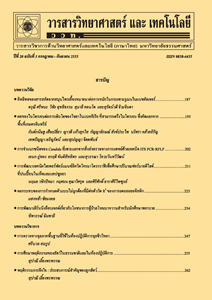ผลกระทบของการเปลี่ยนแปลงภูมิอากาศต่อดินถล่มในพื้นที่ลุ่มน้ำทะเลสาบสงขลาและพื้นที่ใกล้เคียง
Main Article Content
Abstract
บทคัดย่อ
บทความวิจัยนี้เป็นผลการทำแผนที่ด้วยภูมิสารสนเทศและวิเคราะห์การเปลี่ยนแปลงสภาพภูมิอากาศที่มีต่อแผ่นดินถล่มในลุ่มน้ำทะเลสาบสงขลาในสามทศวรรษ พื้นที่ศึกษาครอบคลุม 5 จังหวัด คือ สงขลา พัทลุง นครศรีธรรมราช สตูล และตรัง ฐานข้อมูลแผ่นดินถล่มประกอบด้วย 8 ปัจจัย ซึ่งได้สร้างแผนที่ฝนตกสูงสุด แผนที่ภูมิสัณฐานหรือแบบจำลองชั้นความสูงเชิงตัวเลข แผนที่ธรณีวิทยา แผนที่ความลาด แผนที่ทิศทางรับน้ำฝน แผนที่ทางน้ำ แผนที่รอยแตก และแผนที่การใช้ประโยชน์ที่ดินหรือสิ่งปกคลุมดิน ถ่ายจากดาวเทียมแลนด์เซ็ท 5 ระบบ TM ได้นำมาใช้ในการศึกษาการเปลี่ยนแปลงการใช้ที่ดิน รายงานที่ผ่านมามาใช้อ้างอิงเพื่อสร้างแผนที่หัวเรื่อง การระบุพื้นที่เปราะบาง ปัจจัยที่กล่าวมาใช้วิเคราะห์ในระบบสารสนเทศภูมิศาสตร์โดยกำหนดช่วงค่าและน้ำหนักคะแนน ผลการผลการประมวลผลแผนที่บริเวณภัยแผนดินถล่มแสดงพื้นที่มีหลายระดับขั้นความเสียหายจากแผ่นดินถล่ม จำแนกออกเป็น 4 ระดับ คือ เสียหายต่ำ ปานกลาง สูง และสูงมาก ผลวิเคราะห์ดัชนีแผ่นดินถล่มสามารถเสนอแนะไปดำเนินมาตรการบรรเทาภัยอย่างเหมาะสม อันช่วยป้องกันการสูญเสียชีวิตและอสังหาริมทรัพย์ในพื้นที่ลุ่มน้ำทะเลสาบสงขลา
คำสำคัญ : แผ่นดินถล่ม; ภูมิสารสนเทศ; ลุ่มน้ำทะเลสาบสงขลา; สภาพความเปราะบาง
Abstract
Geo-informatic technics approach to mapping and assess the climate change in three decades of the Songkhla Lake Basin landslides investigation. Study area covered 5 provinces including Songkhla, Phatthalung, Nakhon Si Thammarat, Satun and Trang provinces. Landslide database involves eight generation of highest rainfall map, geomorphic map or DEM, geologic map, slope map, aspect, drainage, fracture map, and landuse/land cover change map. Landsat 5-TM images have been input data to process landuse change maps. Existing literatures have also been referred to generate the thematic maps. To identify the vulnerable areas, the above-mentioned parameters were analyzed in a GIS by assigning appropriate ranks and weights. The result is a landslide hazard zonation map showing areas with varying degrees of vulnerability from landslides. The landslide vulnerability map was classified into four zones such as low, moderate, high, and very high. It is pointed that a map which is derived from the analysis of the landslide index will enable to propose and implement suitable mitigating measures, thus preventing loss of life and property in the Songkhla Lake Basin.
Keywords: landslide; geo-informatics; Songkhla Lake Basin; vulnerability


